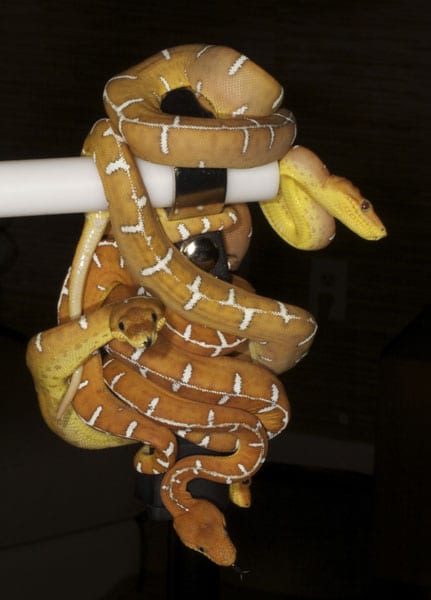Tips and secrets for breeding Corallus caninus.
Breeding emerald tree boas (Corallus caninus), although challenging, is an extremely rewarding and gratifying experience. Emerald tree boas live to between 20 and 30 years of age and reach sexual maturity in captivity between 3 and 4 years. Specifically, males can be bred as early as 3 years of age and 800g body weight; females do better at a minimum of 4 years of age and at least 1,500g body weight. Females should only be bred once every two years because they need a recovery period from their long gestation. They will typically give birth to four to 12 babies, although litters of up to 25 have been documented.
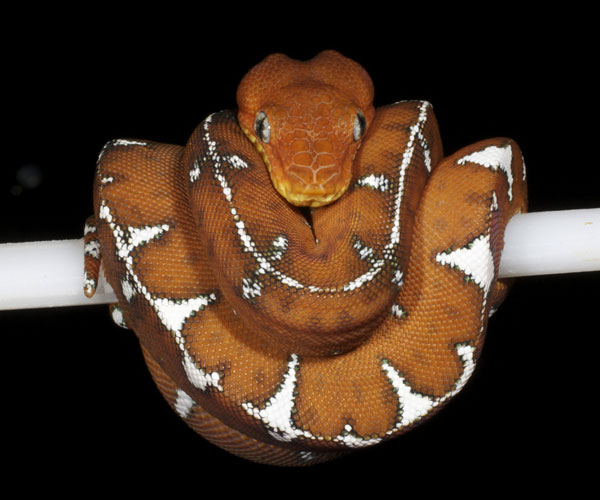
Photo by Steve Volk
Juvenile emerald tree boas tend to be coral colored.
The key to successfully breeding emerald tree boas is having well-adjusted animals in a stable environment. We temperature-cycle our adult Amazon Basin emerald tree boas in Colorado starting in October, maintaining them at a daytime ambient temperature of 84 degrees Fahrenheit with a nighttime drop between 78 and 72 degrees. The 6-degree nighttime drop is dependent on outside weather conditions, because the only heat source in our breeding room is from the cage heat panels. So, if the outdoor temperature drops to freezing or below, our snake room will drop to a nighttime low of 66 degrees and our cages will hit a nighttime low of 72 degrees. We also reduce the snakes’ photoperiod from 12 hours on/12 hours off to 11 hours on/13 hours off from October through March.
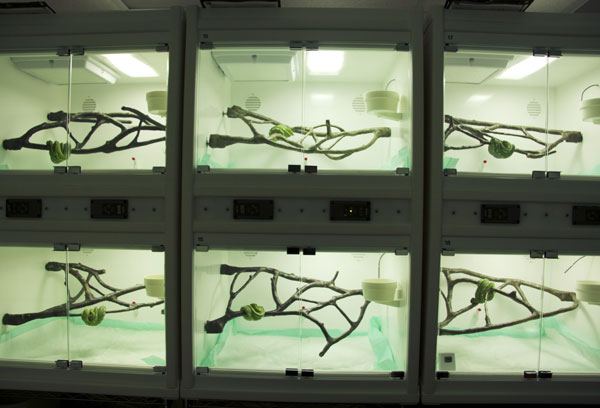
Photo by Steve Volk
Enclosures for juvenile emerald tree boas.
We introduce male emerald tree boas to females in November, using the females’ cages as the breeding sites. Pairing animals is best done during daylight hours so as to avoid any accidental bites due to a feeding response. Males will normally court and copulate with females that are properly conditioned shortly after dark. Pairs may remain joined for several hours and even into the next morning.
Introduce one male to a female. Introducing multiple males can result in fights with disastrous results. Upon introduction, a male emerald tree boa will cruise the cage, tongue-flick the female, and become defensive. Initially, it is important to watch the female for potential fighting. It is rare, but females have been known to become combative.
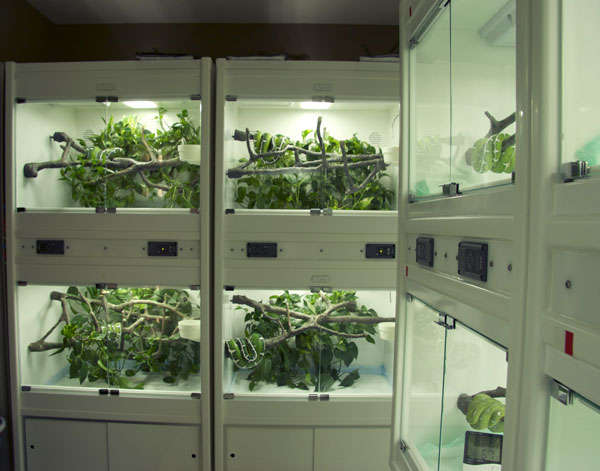
Photo by Steve Volk
Adult emerald tree boa enclosures. Males are introduced into females’ enclosures for breeding.
We separate the pairs after a week or so, for a break and feeding should it be time for a meal. One male can comfortably breed two females in a season. If you are uncertain whether or not breeding activity took place, a second “backup” male can be cycled into the rotation. We use Internet cameras with infrared capabilities to observe and record nighttime breeding behavior.
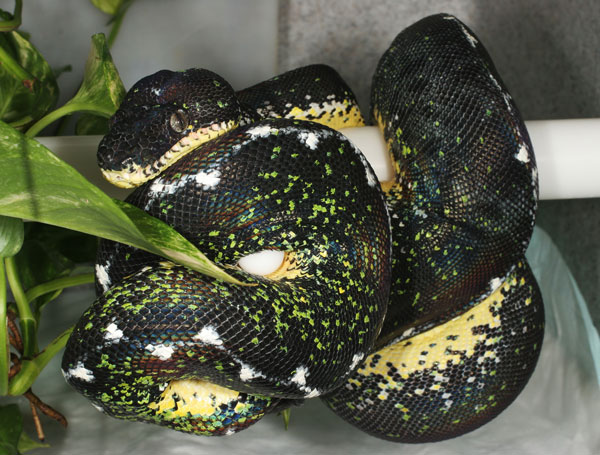
Photo by Steve Volk
The key to successfully breeding emerald tree boas is having well-adjusted animals in a stable environment. This is a male black Amazon Basin emerald tree boa.
After successful copulations over a period of several weeks, the female will begin ovulating and develop a large mid-body swelling, giving the appearance that the female has eaten an excessively large meal. This swelling normally lasts 12 to 24 hours. A post-ovulation shed will occur approximately 30 days after ovulation. Once ovulation has occurred, the male can be separated from the female and nighttime temperatures brought back to normal settings.
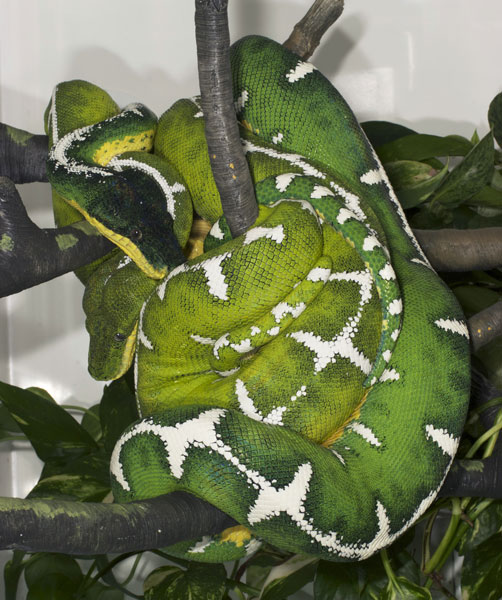
Photo by Steve Volk
A cuddling pair of adult Amazon Basin emerald tree boas.
It is important that the female has a basking site during her gestation period. For this, we provide a 40-watt heat panel, which can achieve basking site temperatures in the low 90s. A successful pregnancy will last 130 to 180 days from the female’s post-ovulation shed, depending on temperature. Most females will not eat during their gestation period.
Hydration is critical for females during the gestation period, to avoid retained or adhered ovum during birth. In addition to maintaining fresh water in a bowl mounted next to a female’s perch, we will often place a gravid female in our rain chamber, where temperature-controlled water will rain down. Females will often drink off their coils or the walls of the chamber for 20 minutes or more during these sessions.
Emerald tree boas are ovoviviparous and give birth to live young. First-time mothers will usually have four to eight babies; mature females can have up to 18 or more. Neonates are generally brown in coloration and take up to six months or so to fully turn green (known as the ontogenetic color change). Healthy young emerald tree boas will be in the 12- to 14-inch range and can weigh up to 50g.
Newborns are kept individually in Habitat Systems racks using 5-gallon, 18-by-12-by-9-inch tall Rubbermaid polycarbonate clear tubs with internal perches. Perches should be positioned so the snakes can reach the bottom of the tub easily to drink or strike at prey.
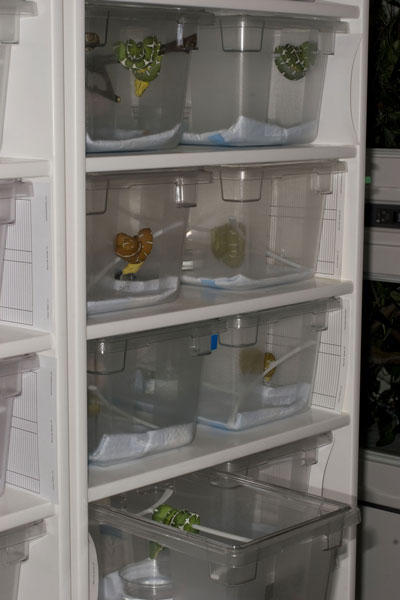
Photo by Steve Volk
Enclosures for baby emerald tree boas.
Getting newborn emerald tree boas to begin eating can be particularly challenging with Amazon Basin emerald tree boas (the northern form of emerald tree boa is less challenging). Food is not offered until after the first shed occurs within two weeks from birth, at which time most of the yolk will be absorbed. Newborns are offered frozen/thawed (F/T) rat pinkies held with tweezers over a hot vapor humidifier until they are hot to the touch prior to being offered to a baby emerald.
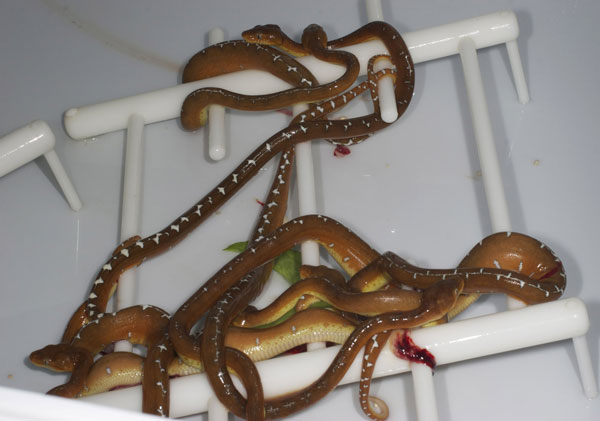
Photo by Steve Volk
Freshly born Amazon Basin emerald tree boas. Getting them to eat can sometimes be challenging, but they usually come around to accepting frozen/thawed rat pinkies.
Typically, about half of an emerald tree boa litter will accept F/T rat pinkies as its first meal. Those that refuse are offered a live dwarf hamster or hopper mouse in a deli cup left in their tubs overnight. About half of those snakes will take the live prey, leaving 25 percent of the litter to be assist fed with a rat-tail or mouse hopper. Eventually, the entire litter will come around and become aggressive feeders. The objective is to get neonates eating F/T rat pinkies as soon as possible; as soon as this is accomplished, your snakes will become easy and consistent feeders for life.
Rico Walder lives in Signal Mountain, Tenn., and has been keeping and breeding reptiles since 1979. He worked in several AZA (Association of Zoos & Aquariums) facilities for 20 years before committing to his company, Signal Herpetoculture (www.signalherp.com), full time in 2007. He is internationally known and considered one of the top green tree python breeders in the world.
Steve Volk lives in Boulder, Colo., with his wife, Golden Retriever and about 65 Amazon Basin emerald tree boas. He has bred various boas and pythons over the last 30 years, and for the past eight has focused on the Amazon Basin emerald, with the objective of producing high-white, deep emerald green animals as well as the ultra-rare, naturally occurring “black” or melanistic Amazon Basin emerald. He has a BS in Zoology from Duke University and a Doctor of Dental Surgery from the University of Missouri. Visit his website at www.amazonbasins.com.

